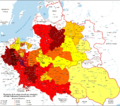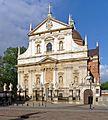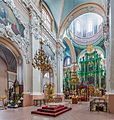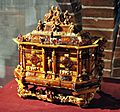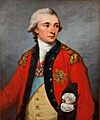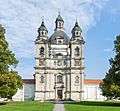Polish-Lithuanian Commonwealth facts for kids
Quick facts for kids
Crown of the Kingdom of Poland and the Grand Duchy of Lithuania
Rzeczpospolita Obojga Narodów
|
|||||||||||||||
|---|---|---|---|---|---|---|---|---|---|---|---|---|---|---|---|
| 1569–1795 | |||||||||||||||
|
Motto: Latin: Si Deus nobiscum quis contra nos (If God is with us, then who is against us)
Pro Fide, Lege et Rege (Latin: For Faith, Law and King, since 18th century) |
|||||||||||||||
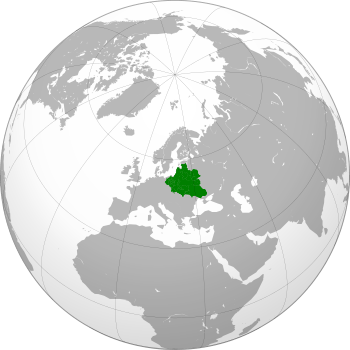
The location of Polish–Lithuanian Commonwealth
|
|||||||||||||||
| Capital | Commonwealth and Crown of the Polish Kingdom: Kraków, Warsaw ca. 1600; Grand Duchy of Lithuania: Vilnius | ||||||||||||||
| Common languages | |||||||||||||||
| Religion |
Roman Catholic (state religion)
Greek Catholic Eastern Orthodox Church Protestantism (various sects) Judaism Islam (mainly Tartars and Turks) |
||||||||||||||
| Government | Monarchy | ||||||||||||||
| King & Grand Duke | |||||||||||||||
|
• 1569–1572
|
Sigismund II Augustus | ||||||||||||||
|
• 1764–1795
|
Stanisław II Augustus | ||||||||||||||
| Legislature | Sejm | ||||||||||||||
|
• Privy Council
|
Senate | ||||||||||||||
| History | |||||||||||||||
| July 1 1569 | |||||||||||||||
|
• fief of the Ottoman Empire
|
1672-1676 | ||||||||||||||
|
• Protectorate of the Russian Empire
|
1768 | ||||||||||||||
|
• 1st Partition
|
August 5, 1772 | ||||||||||||||
|
• May 3rd Constitution
|
May 3, 1791 | ||||||||||||||
| January 23, 1793 | |||||||||||||||
|
• 3rd Partition
|
October 24 1795 | ||||||||||||||
| Area | |||||||||||||||
| 1582 | 815,000 km2 (315,000 sq mi) | ||||||||||||||
| 1618 | 1,153,465 km2 (445,355 sq mi) | ||||||||||||||
| Population | |||||||||||||||
|
• 1582
|
6500000 | ||||||||||||||
|
• 1618
|
10500000 | ||||||||||||||
|
|||||||||||||||
| Today part of | |||||||||||||||
The Polish–Lithuanian Commonwealth was a huge country in Europe. It existed from 1569 to 1795. It was formed when the Kingdom of Poland and the Grand Duchy of Lithuania joined together. They had been connected since 1386.
This Commonwealth was one of the biggest and most populated countries in Europe during the 16th and 17th centuries. Its lands covered much more than just modern-day Poland and Lithuania. It also included parts of what is now Belarus, Ukraine, Latvia, and western Russia.
The Commonwealth was known for having many different groups of people. It also allowed a lot of religious freedom. This freedom changed a bit over time.
After a time of being strong and successful, the Commonwealth started to get weaker. It faced problems with its government, army, and economy. In the end, it was divided up by its powerful neighbors: Austria, Prussia, and the Russian Empire. This happened in stages, with the final division in 1795.
Contents
What Was the Polish-Lithuanian Commonwealth?
The Polish–Lithuanian Commonwealth was a special kind of country. It was a union of two separate states, Poland and Lithuania. They shared one ruler, who was both the King of Poland and the Grand Duke of Lithuania. This union was created by the Union of Lublin treaty in 1569.
A Giant Country
The Commonwealth was truly massive for its time. It covered about 400,000 square miles (about 1,036,000 square kilometers). At its peak, around 11 million people lived there. These people came from many different backgrounds and spoke various languages.
For about 200 years, the Commonwealth was a strong power. It fought many wars against other big European powers. These included the Russians from Muscovy, the Ottoman Empire, and the Swedes.
A Special Government
The Commonwealth had a unique system of government. It developed laws and a parliament called the Sejm. This system worked to limit the power of the king. It was an early example of a constitutional monarchy, where the ruler's power is limited by a constitution.
Even though Poland and Lithuania were supposed to be equal partners, Poland usually had a stronger role. The Commonwealth also created the first national constitution in Europe in 1791. This was a very important step for its time.
Languages and Religions
Many languages were spoken in the Commonwealth. In Poland, the main languages were Polish and Latin. In Lithuania, people spoke Old Belarusian, Latin, and Lithuanian. Other languages like German, Hebrew, and Yiddish were also common.
The Catholic Church had a strong influence in the Commonwealth. However, the government allowed people of many different religions to practice their faith. This meant that people who were Catholic, Greek Catholic, Orthodox, Protestant, Jewish, and Muslim lived side-by-side. The Warsaw Confederation of 1573 was an important act that guaranteed religious freedom.
Daily Life and Economy
Most people in the Commonwealth worked in farming. This was the main way people earned a living. The country was known for exporting grains.
Why Did It End?
After a long period of success, the Commonwealth began to decline. It faced many challenges, including wars and internal political problems. Its neighbors, the Russian Empire, Prussia, and Austria, grew stronger.
These powerful neighbors started to take parts of the Commonwealth's land. This process is known as the Partitions of Poland. The first partition happened in 1772. The second in 1793, and the third and final one in 1795. After the third partition, the Polish–Lithuanian Commonwealth ceased to exist as an independent country.
Images for kids
-
The Kingdom of Poland and the Grand Duchy of Lithuania in 1526.
-
The Union of Lublin joined the Kingdom of Poland and the Grand Duchy of Lithuania in 1569.
-
Sigismund III Vasa, who reigned between 1587 – 1632, presided over an era of prosperity and territorial expansion of the Commonwealth.
-
John III Sobieski, victor over the Ottoman Turks at the Battle of Vienna in 1683.
-
Augustus II the Strong, King of Poland and Elector of Saxony, wearing the Order of the White Eagle which he established in 1705.
-
Partitions of Poland in 1772, 1793 and 1795.
-
A historical re-enactor dressed in the Polish Winged Hussars armour
-
Krasiczyn Castle was built between 1580-1631 in the mannerist style.
-
Wilanów Palace, completed in 1696, exemplifies the opulence of royal and noble residences in the Commonwealth.
-
Population density of the Commonwealth per each voivodeship in 1650
-
Saints Peter and Paul Church in Kraków was built between 1597-1619 by the Jesuit order
-
Rococo iconostasis in the Orthodox Church of the Holy Spirit in Vilnius, designed by Johann Christoph Glaubitz, 1753–1756
-
Stanisław Poniatowski, Commander of the Royal Guards and Grand Treasurer. Painted by Angelika Kauffmann in 1786.
-
Equestrian portrait of King Sigismund III of Poland, by Peter Paul Rubens, 1624
-
Tapestry with the arms of Michał Kazimierz Pac, Jan Leyniers, Brussels, 1667–1669
-
Silver tankard by Józef Ceypler, Kraków, 1739–1745
-
Example of the merchant architecture: Konopnica's tenement house in Lublin, 1575
-
Taurus Poniatovii, constellation originated by Marcin Poczobutt in 1777 to honor the king Stanisław II Augustus
-
Branicki Palace in Białystok, designed by Tylman van Gameren, is sometimes referred to as the "Polish Versailles."
-
Pažaislis Monastery in Kaunas, Pietro Puttini, built 1674–1712
-
Church of St. Peter and St. Paul in Vilnius, Pietro Puttini, built 1675-1704
-
Zamość City Hall, designed by Bernardo Morando, is a unique example of Renaissance architecture in Europe, consistently built in accordance with the Italian theories of an "ideal town."
See also
 In Spanish: República de las Dos Naciones para niños
In Spanish: República de las Dos Naciones para niños

















